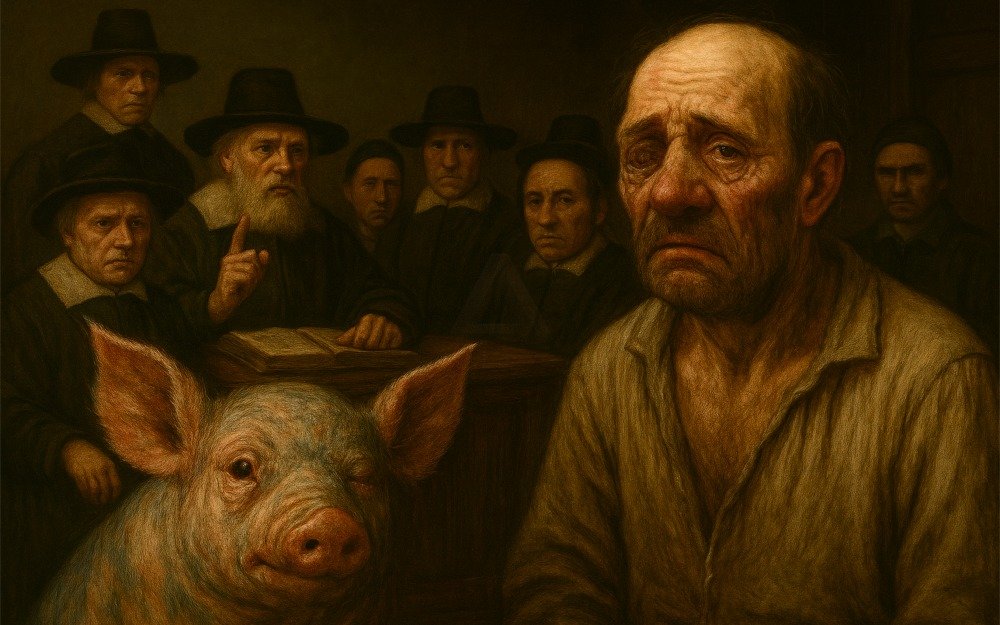
Last updated: 30 September 2025
In 1642, George Spencer was executed in the New Haven Colony due to his resemblance to a malformed piglet. The case was documented without commentary, maintained without alterations, and stands as one of the most peculiar legal artifacts from colonial America.
Spencer was not a prominent man. He was a servant, known for his solitary habits and physical appearance, which the court described as “singular.” He had one eye, a flattened nose, and a mouth that turned downward. When a sow gave birth to a deformed piglet, a resemblance was noted.
The Colony
New Haven was not a secular experiment. It was a theocratic settlement, built by Puritan dissenters who believed English law had drifted from biblical truth. Their legal code was drawn from Deuteronomy, Leviticus, and the Gospel of Matthew. Magistrates consulted theology as precedent. Signs and omens were admissible. Confession was not just evidence — it was confirmation.
The sow belonged to William Mead. She gave birth to a litter of piglets, one of which was malformed. It had a single eye in the centre of its head, a flattened snout, and a mouth that turned downward. Mead said it resembled Spencer. The resemblance was not treated as a coincidence. It was treated as divine revelation.
The Trial: Confession, Retraction, and the Court’s Dilemma
Spencer was summoned and denied any involvement. The court offered mercy for a confession and Spencer obliged. He said the devil had tempted him.
When it became clear that the promise of mercy would not hold — it was God’s mercy that had been promised, not the court’s — Spencer retracted his confession and claimed innocence. But the detailed confession stood. He’d admitted to “filthy dalliance” with the sow and described the act, the timing, and the location.
New Haven’s legal code required two witnesses for a capital conviction. This was from Deuteronomy 17:6: “At the mouth of two witnesses, or three witnesses, shall he that is worthy of death be put to death.” The court faced a dilemma. There was no eyewitness to the alleged act. No physical evidence. No confession — until one was coerced. And no second witness.
The use of resemblance as evidence was not unique to New Haven. In early modern Europe, courts sometimes admitted physical likeness as proof of paternity, guilt, or divine judgment. But in Spencer’s case, the resemblance was not between two humans. It was between a man and a piglet.
The piglet became one witness. Spencer’s confession — given under a promise of mercy — became the second.
The second witness rule was meant to prevent wrongful execution. In this case, it enabled it. The piglet was not a person. It could not testify. But its physical malformations were treated as testimony.
The sow was convicted. So was the George Spencer. Both were sentenced to death.
The Execution
The sentence was carried out without delay. There was no appeal. No reconsideration. The colony had its verdict.
Spencer was hanged on April 8, 1642, and the sinful sow — ever silent — was put to the sword.
Spencer was the first colonist executed in Connecticut. The sow became a mere footnote. The piglet was preserved temporarily, then discarded.
The case was recorded in the colonial archives with minimal commentary. It was not treated as unusual. Justice had been served.
No one protested. No one petitioned. No one mourned. The case didn’t change anything. It merely confirmed what most already believed: that sin could be seen and that justice didn’t need to explain itself.
The Offical Record and The Aftermath
The case is recorded in the Records of the Colony and Plantation of New Haven from 1638 to 1649, presented without editorial framing. The language used is procedural, and the tone is flat. The resemblance between George and the piglet is noted as a fact.
There was no discussion about bestiality as a psychological condition, no inquiry into coercion, and no recognition of duress. The court addressed the case with moral certainty.
Spencer’s voice is present — but only in fragments. His confession is recorded in detail. His retraction is noted, then dismissed. He speaks, but is not heard. He is described, discussed, and judged. The record preserves his words, but not his agency.
The sow is treated as a legal subject. She is tried, convicted, and executed. Her role is not symbolic; she is a defendant.
George Spencer’s trial and punishment ranks among the most unsettling cases in colonial America. The resemblance between the man and the piglet became evidence. The confession served as confirmation, while the retraction proved irrelevant.
Legacy: The First Execution and The Folklore It Spawned
Over time, the story evolved. The piglet’s features were exaggerated in retellings, and Spencer’s face became stranger. The resemblance shifted from being a detail to becoming the primary focus.
Centuries later, the case was reopened. A Connecticut judge reviewed the confession, the evidence, and the piglet. Spencer was posthumously exonerated. The sow was not mentioned.
Although the pardon didn’t alter the outcome, it confirmed what most had believed — that suspicion outweighed evidence. Spencer was convicted by what people suspected, not by what they knew.
🔗 Think that was strange? There’s more. Explore our full Colonial America archive.
References:
- Records of the Colony and Plantation of New Haven, from 1638 to 1649. Charles J. Hoadly, ed. New Haven: Case, Tiffany and Company, 1857. [Primary source]
- Blue, Jon C. The Case of the Piglet’s Paternity: Trials from the New Haven Colony, 1639–1663. Wesleyan University Press, 2015. [Legal and theological context]
- Connecticut State Library. “George Spencer Posthumous Pardon.” Accessed 12 August 2025. https://ctstatelibrary.org [Judicial review and legacy]
- Yale Law Journal. “The Second Witness Rule in Colonial Jurisprudence.” Vol. 132, No. 4 (2023): 812–839. Accessed 14 August 2025.
- Folklife Archive, Library of Congress. “Animal Trials in Early Modern Europe.” Accessed 14 August 2025.
- New Haven Colony Historical Society. “Puritan Law and the Theology of Signs.” Exhibition Notes, 2022. Accessed 14 August 2025.

Great insight. Well done.